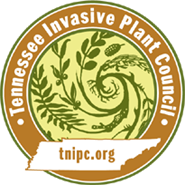Vinca minor L.
Common Periwinkle
| Threat Level |
Category |
| Established |
Vine |
Description
Height
Periwinkles are evergreen to semi-evergreen vines, somewhat woody, trailing or scrambling to 3 feet (1 m) long and upright to 1 foot (30 cm).
Stem
Stems are slender in common periwinkle and stout in bigleaf periwinkle. Succulent stems become somewhat woody (tough to break) with flowering branches erect and jointed at axils. Stems are hairless, smooth and dark green at the base to light green upward with a reddish tinge.
Leaves
Leaves are opposite, glossy and hairless, somewhat thick, with margins slightly rolled under. Common periwinkle foliage is narrow elliptic, 0.8 to 1.8 inches (2 to 4.5 cm) long and 0.4 to 1 inch (1 to 2.5 cm) wide, with petioles 0.1 inch (1 to 3 mm) long. Bigleaf periwinkle foliage is heart-shaped to somewhat triangular to elliptic, 1.5 to 2.5 inches (4 to 6 cm) long and 1 to 1.5 inches (2.5 to 4 cm) wide, with petioles 0.2 to 0.4 inch (5 to 10 mm) long. Blades are dark green with whitish lateral and midveins above and lighter green with whitish midveins beneath. Some varieties are variegated.
Flowers
Periwinkles flower April to May and sporadically from May to September. Fowers are axillary, usually solitary, violet to blue lavender (to white), with five petals radiating pinwheel-like at right angles from the floral tube. Common periwinkle flowers are 1 inch (2.5 cm) wide with a 0.3- to 0.5-inch (8- to 12-mm) long tube, and bigleaf periwinkle flowers are 1.5 to 2 inches (4 to 5 cm) wide with a 0.6- to 0.8-inch (1.5- to 2-cm) long tube. Five sepals are long lanceolate, about 0.4 inch (1 cm), and hairy margined.
Fruit and Seeds
May to July. Slender, cylindrical fruit to 2 inches (5 cm) long, becomes dry and splits to release three to five seeds.
ImagesLife History
ommon and Bigleaf or Greater Periwinkle are evergreen to semi-evergreen vines, somewhat woody, trailing or scrambling to 3 feet (1 m) long and upright to 1 foot (30 cm), with violet pinwheel-shaped flowers. Both plants are used as ornamental groundcovers; common periwinkle was oftenn planted in cemeteries and is sometimes called graveyard plant. They are members of the Apocynaceae or Dogbane family. Ecology and Habitat
Periwinkles are often found around old home site plantings and have scattered in open to dense canopied forests. They form mats and extensive infestations even under forest canopies by vines rooting at the nodes. The viability of seeds has yet to be reported. Origin & Distribution
Introduced from Europe in 1700s, periwinkles are ornamental groundcovers, commonly sold and planted by gardeners.
Vinca major - Other states where invasive: WA, OR, CA, UT, AZ, NM, LA, GA, NC, MD.
Vinca minor - Other states where invasive: WA, OR, CA, TX, GA, SC, NC, VA, KY, WV, MD, NJ, RI, CT, PA, NY, OH, IN, MI, IL, IA, WI.
Source: Information on this plant page is derived primarily from James H. Miller's Nonnative Invasive Plants of Southern Forests, USDA Forest Service.Management Recommendations
3. Herbicidal Control Foliar Spray Method
Thoroughly wet all leaves (until runoff) with one of the following herbicides in water with a surfactant (July to October for successive years):
Tordon 101 ‡ as a 3-percent solution (12 ounces per 3-gallon mix), Tordon K ‡ as a 2-percent solution (8 ounces per 3-gallon mix), or Garlon 4 as a 4-percent solution (15 ounces per 3-gallon mix).
Or, during the growing season, repeatedly apply Garlon 4 or a glyphosate herbicide as a 2-percent solution in water (8 ounces per 3-gallon mix) with a surfactant. In winter, herbicide treatments should be limited to warm days.
Nontarget plants may be killed or injured by root uptake.
‡When using Tordon herbicides, rainfall must occur within 6 days after application for needed soil activation. Tordon herbicides are Restricted Use Pesticides.
